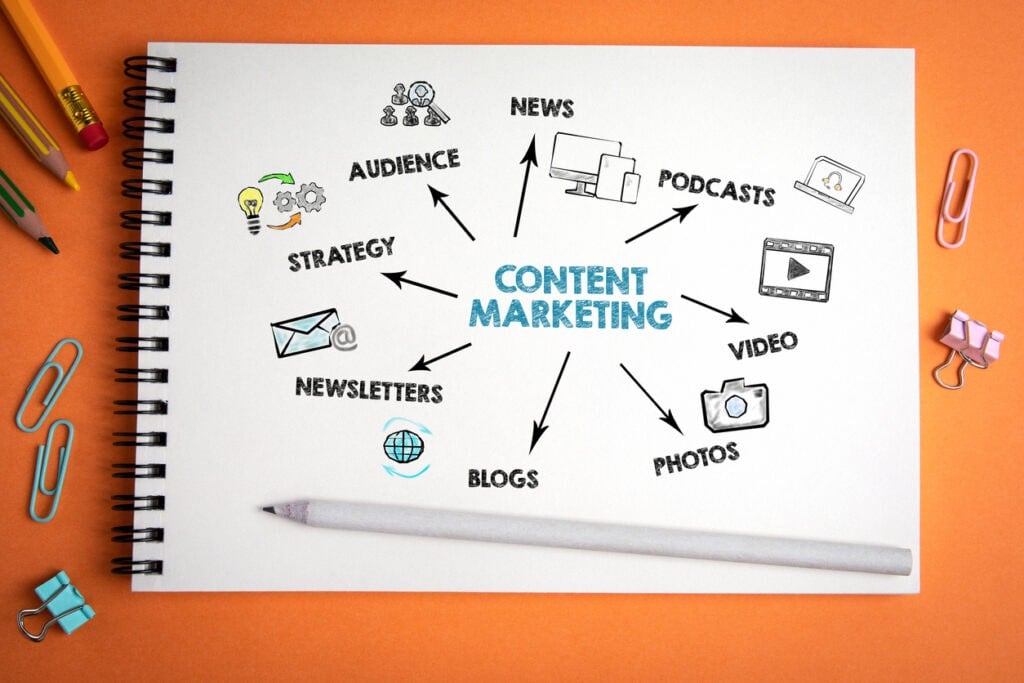Contents

Coming up with a content strategy for affiliate marketing is a tough task. There are all kinds of different material you can create, and you'll spend a lot of time making it. The process is easier if you know what you should craft, so you put your effort into the right areas.
As a whole, affiliate marketing takes time and nurturing, but it also involves narrowing down a variety of methods that might work for your niche. You'll spend a lot of your content planning in the who and what stages, and it's best to have your audience (and what you'll offer them) down to a science.
With a pandemic going on, you also want to consider ways to pull in a broader audience (in areas you may not have nurtured as much in the past).
Below, we'll talk about some of the types of content you can create for affiliate marketing and advise on what works best (no matter the global situation).
Who Is Your Target Audience?

Want to know a secret to perfect marketing? Answer these questions: who am I talking to, and what do they want right now?
It's your one-size-fits-all quick start. Answering those questions will create the best content marketing plans for you in any niche, market, or industry. Ask yourself who you are making the content for and what information or guidance they need in order to solve their problem, and then get to work making content that will help.
So, how can you present the solution in a way that moves your readers to action?
Here's a quick example: Imagine you're trying to get beginner vloggers to buy a new camera. How would you present the camera? Imagine that these vloggers have never picked up a camera before, and they're searching online for tutorials to help them get started.
Wouldn't it make sense to show the specs that make your affiliate's camera more comfortable for vloggers at any skill level? Wouldn't it also help to show the camera against a popular competitor, and go over how it makes recording easier? Maybe you could also put your affiliate links in a post about software that makes the uploading process a breeze with the camera.
With that list alone, you have three different types of content for one affiliate: a product review video (which could double as a product review blog), a product comparison video, and a general blog on software.
Depending on your audience, you could stretch the content even further with audio, video, and more. Your challenge is first figuring out how you're going to solve the audience's problem in a way that resonates with them, then you can expand and conquer.
Affiliate marketing is about helping someone else solve a problem, but your audience belongs to you, not the affiliate programs you promote. How you amplify the affiliate program's solution will determine the degree to which your audience trusts you and whether they follow you from one affiliate program to another.
Once you've figured out who your audience is and what they need, you should find out where your audience is most comfortable and what your target market responds to. This step can't be skipped.
To figure out what your audience wants, you need to know:
- Who is your target audience?
- Where is your target audience?
- Why does your target audience need your product?
Once you've narrowed down the who, what, where, and why, it's time to find the content that fits your needs the best.
What Counts As Content?

Content can be a lot of different types of work — creative and non-creative. For example:
- Blogs
- Email campaigns
- Videos and vlogs
- Podcasts
- Infographics
- Art and writing
- Presentations
- Case studies
- Reviews
The go-to marketing pieces for most creators are blogs/vlogs, and they're great for affiliate marketing! In fact, we could write an entire book on the different types of blog posts that work. However, it's important to become familiar with the other forms of engaging content you can add to your arsenal, so we'll focus on a broader range of material in this post.
An important thing to consider is how you generate your content ideas. We suggest Buzzsumo, a fantastic tool that allows for in-depth research into keywords so that you know your posts/vlogs/so on will talk about what's hot these days.
Following are several types of content (in addition to blogs and vlogs) that work best for affiliate marketing:
Product Reviews
As many famous writers have taught us, showing is better than telling!
Product reviews give your audience an in-depth look at the solution you're offering. Reviews are fantastic for affiliate marketing content because they help your audience understand what they might be missing if they skip over your affiliate product.
In reviews, you can get down to the specific details of why your product works and its benefits, as well as build trust by pointing out both the pros and cons of your product.
Reviews give customers a sense of your knowledge and trustworthiness, so be honest in your critique. If you don't like a particular aspect of a product, you're not obligated to spice it up. After a while, your honesty in reviews will inspire people to trust what you have to say.
Product reviews are excellent in both video and written form.
Case Studies
If your audience is more interested in anecdotes and storytelling than specs and metrics, case studies are your wheelhouse. They work especially great for B2B.
Case studies are stories about how your affiliate product has helped you (or someone else) overcome a problem. They're structured as a problem, a solution, and a conclusion, with the product as the hero of the story every time.
You want case studies to have a high level of relatability. If your reader can't imagine themselves solving a similar issue, it's a loss. Real stories of problems solved thanks to the benefits of your affiliate product will come across as much more authentic than made-up scenarios, so only use a case study when you have a real story to tell.
Remember that case studies are all about a journey the potential customer can easily imagine themselves on. You're not boasting about the product or company. You're sharing the solution the product enables!
Case studies work well in email campaigns, anywhere on your website, and on social sites like LinkedIn.
Guides and Ebooks
Everybody can be a teacher these days! Downloadable guides, whether free or used as tripwires, showcase your expertise in your niche. Downloads help you get one step closer to your audience by introducing a give and take. Your audience gives you their information (typically via a form), and you give them valuable insight and solutions in return.
Because ebooks are electronic, affiliate links can be added in the actual copy. This is a great way to build and nurture trust around your links. Also because they're electronic, you can deliver ebooks directly via email campaigns (more on that later).
Choose your topics based on your earlier research into what your audience wants and needs. Keep in mind you can also create guides using older blog posts. And be sure to create branded landing pages with compelling and persuasive copywriting to distribute the content neatly and effectively.
Ebooks and guides are best for your website, social media platforms (Facebook has a great option to create in-app downloads in the form of ads), and landing pages.
Tutorials
How do I and How do you are highly searched terms on Google and YouTube. And tutorials are a form of content that address these questions. The great thing is, they work for almost every affiliate marketing niche.
Like guides and ebooks, tutorials help you establish yourself as an expert. Consider tutorials your own small courses (or entire series) that teach your viewers, readers, or listeners the best ways to achieve their goals.
Your topics should be relevant enough to your niche that understanding how to do the things you're teaching will push your audience to buy your affiliate products.
Social media platforms lend themselves to video tutorial posts, so optimize your videos for LinkedIn, Instagram, Facebook (which prefers native video posts to YouTube or Vimeo links), Twitter, and YouTube. You can even take pieces of each video to stretch the content across platforms.
Product Comparison
We've covered product comparison videos before — and for good reason. This type of highly digestible content can be an excellent asset to your affiliate marketing, because you can often pitch two of your affiliate products at once without taking the value out of either.
As mentioned, a product comparison video is a video that pits one product against another, showing features and perks of both. Product comparisons mainly help viewers decide which product makes the most sense for their budget and needs. The viewer's goal, after all, is to get the highest value for their money.
Emails
Personality sells, which is why email marketing is one of the best types of content for affiliate marketing.
Permission-based email marketing allows you to set up a personalized sales funnel that runs in the background. Once you've crafted your friendly and informative email sequence, the hardest part is done.
You'll want to use an email autoresponder service such as ActiveCampaign or Constant Contact to get your emails out as efficiently as possible. These services will allow you to compile email lists and optimize your campaigns based on initial results.
Over time, if you connect your email campaigns with other types of content (ebooks and guides), you can build a valuable audience that expects and enjoys your campaigns.
Also, affiliate links in emails perform well, especially when you've already built a relationship with your audience.
Conclusion: The Best Content Builds Relationships
When you're coming up with a content marketing strategy for your affiliate marketing program, always remember that your goal is to build relationships and convert. Your content should always help you establish yourself and nurture relationships as well as showcase your affiliate products and the solutions they deliver.
While you experiment to find your best voice and the best approach for your audience, keep these content types in mind:
- Product reviews
- Case studies
- Guides and ebooks
- Tutorials
- Product comparisons
- Emails
The best affiliate marketing content is made with your platform, audience, and affiliate products in mind. With a little forethought and groundwork, you can build a solid content marketing strategy in no time.
Do you swear by a specific type of content? Does one particular content piece work best for your niche? Let us know in the comments below!



Great post on affiliate marketing! I found your tips on identifying your target audience and creating content that resonates with them very useful. It’s important to remember that the best content marketing plans start with knowing who you’re creating the content for and what they need in order to solve their problem. As someone who is still new to the blogging world, and to affiliate marketing – your suggestions for the types of content that work well for affiliate marketing, including product reviews, case studies, guides and ebooks, tutorials, product comparisons, and emails, were all helpful. I don’t usually comment, but I really appreciate the tips.